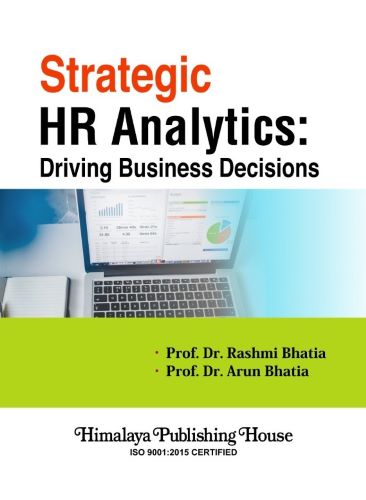Human Resource (HR) Analytics is rapidly transforming the landscape of modern HR management by integrating data-driven decision-making processes. As organizations strive to optimize their workforce and achieve strategic goals, the ability to analyze and interpret HR data has become an essential skill for HR professionals.
This book on “Strategic HR Analytics: Driving Business Decisions” is designed as per the syllabus, to equip students with a comprehensive understanding of the theoretical concepts and practical applications of HR Analytics. This textbook delves into the various facets of HR Analytics, from the evolution of HR information systems to advanced techniques for data analysis and decision support.
Course Objectives:
- Theoretical and Practical Understanding: This book introduces students to both the Theoretical frameworks and Business Applications of HR Analytics, emphasizing the ability to Track, Store, Retrieve, Analyze, and Interpret HR data to support decision-making processes.
- Benchmarking and Metrics: Students will learn to use applicable Benchmarks and Metrics to Conduct Research and Perform Statistical Analyses related to Human Resource Planning, Recruitment, and Selection.
- Software Proficiency: The book emphasizes the use of appropriate Software tools for Recording, Maintaining, Retrieving, and Analyzing Performance and Training effectiveness.
- Compensation Systems: Students will apply Quantitative and Qualitative Analyses to design effective Compensation systems.
- Connecting HR and Business Results: The book aims to demonstrate how HR outcomes can be directly linked to Business results, highlighting the Strategic value of HR Analytics.
Contents –
1. Introduction to HR Analytics –
Evolution of HR Analytics, HR Information Systems and Data Sources, HR Metrics and HR Analytics, Intuition versus ANALYTICAL Thinking, HRMS/HRIS and Data Sources; Analytics Frameworks Like LAMP, HR Scorecard and Workforce Scorecard.
2. Human Resource Planning and Forecasting –
Quantitative and Qualitative Dimensions of HR Planning, Methods and Techniques of HR Demand Forecasting, Data Base for Manpower Forecasting. Recruitment and Selection Analytics: Evaluating Reliability and Validity of Selection Models, Finding out Selection Bias, Predicting the Performance and Turnover.
3. Performance Analysis –
Predicting Employee Performance, Training Requirements, Evaluating Training and Development, Optimizing Selection and Promotion Decisions, Analyzing and Classifying Training Needs, Measuring Training Effectiveness, Predicting Training Effectiveness and Performance. Designing a Compensation System: Understanding Compensation Analytics, Quantifiable Data, Factors Affecting Compensation and Benefits, Analytics for Compensation Planning, Competency Scorecard.
4. Monitoring Impact of Interventions –
Tracking Impact Interventions, Evaluating Stress Levels and Value-Change. Formulating Evidence-based Practices and Responsible Investment, Evaluating Mediation Process, Moderation and Interaction Analysis.
5. Applications of HR Metrics and Creating HR Dashboards –
HR Metrics, Types of HR Metrics, Staffing Metrics, Training and Development Metrics, Application-oriented Exercises: Dashboards: Few Key Excel Add-ins/Functions to Help Create Dashboards, Name Range, The Developer Tab, Form Controls, Important Excel Formulas Useful for Creating Dashboards, VLOOKUP, INDEX, SUMIF, AVERAGEIF and COUNTIF, Application of Excel Functions in Creating HR Dashboards, Storyboarding: Connecting the Dots and Integrating the Findings.
AKTU Question Paper
Case Studies and Real-World Applications







Your review is awaiting approval
gdtoc2